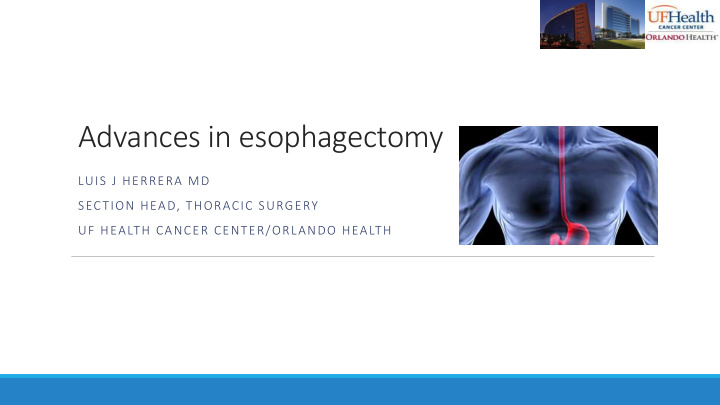



Advances in esophagectomy LUIS J HERRERA MD SECTION HEAD, THORACIC SURGERY UF HEALTH CANCER CENTER/ORLANDO HEALTH
Disclosure -Consultant and Epicenter Surgeon Intui5ve Surgical
Incidence Esophageal Adenocarcinoma • Dramatic increase in incidence of EA in US and Western Europe • In the US 600% increase in the incidence of EA over last 40 years. • Risk factors • GERD weekly symptoms, > 20 yr Hx • Barrett’s • Tobacco • Obesity
ESOPHAGEAL CANCER BARRETT’S Metaplasia-Dysplasia-Adenocarcinoma
The Problem 75-85% of pa5ents with esophageal cancer present with advanced disease Early disease usually found during rou5ne endoscopies and surveillance of Barre@’s esophagus Single modality treatments unlikely to achieve long term survival in advanced disease Significant morbidity and mortality aFer esophagectomy s5ll occurs despite recent improvements
ESOPHAGEAL CANCER: Symptoms at presentaOon Dysphagia (74%) Weight loss (57%) Odynophagia (17%) Regurgita5on or vomi5ng GI bleeding GERD Daly JM et al. J Am Coll Surg 2000;190:562-72.
EUS- Staging Accuracy T stage 84% Accuracy N stage 80% Reed CE Ann Thor Surg 1999
Imaging: CT and PET/CT Useful for diagnosis and staging Useful for ruling out unsuspected metastases (15%) Useful for restaging aFer CRT - Best predictor of post-therapy response - Best predictor of 2yr survival -SUV >4 34% -SUV ≤4 64% Luketich JD et al. Ann Thor Surg 1999 • Clinical stage T3N1M0 (IIIa) Swisher SG et al. Ann Thor Surg 2004
Pa Pathologic CR- Survival Study Patients who Median survival Survival % P value underwent surgery (mo) Urba (2001) pCR 14 49.7 3y 64 P = 0.01 No pCR 36 12 19 Chirieac (2005) pCR 77 133 5y 65 P = 0.003 No pCR 158 10.5 to 38.1 29 Swisher (2005) pCR 86 3y 74 P < 0.001 PR 98 54 > 50% Residual 53 24 Berger (2005) pCR 42 50 5y 48 P = 0.015 PR 13 49 34 No response 76 25 15
Th The g e goa oals: Ge Get a a g good ood p pathol olog ogic r c res espon onse e Re ResecOon of residual disease • Pathologic CR in randomized clinical trials -Neoadjuvant chemotherapy – 2.5% to 15% -Neoadjuvant chemoradiotherapy – 10-28% • Several trials have demonstrated improved survival in patients achieving pCR
So, what is standard of care? For stage IIb and higher, most ins5tu5ons would use induc5on therapy American trial comparing surgery to chemoradia5on followed by surgery closed early due to poor accrual to the surgery alone arm (CALGB 9781) Analysis of 56 enrolled in CALGB, results favored neoadjuvant therapy (5 yr survival 39% vs 16% in surgery alone arm) Tepper J et al. J Clin Oncol. 2008 Mar 1;26(7):1086-92
Surgical Approaches to Esophageal Cancer (INCISIONS AND ANASTOMOSIS) OPEN MINIMALLY Oncologic Anastomotic Pulmonary “Teachability” INVASIVE clearance complication complication TRANSHIATAL/ LAPAROSOPY/ Cervico- + ++ + + OPEN NECK OPEN NECK Abdominal (THE) LAPAROTOMY/ LAPAROSCOPY/ Abdomino- ++ + ++ +++ THORACOTOMY THORACOSCOPY Thoracic (ILE) LAPAROTOMY/ LAPAROSCOPY/ Cervico- +++ ++ +++ ++ THORACOTOMY/ THORACOSCOPY/ Abdomino- OPEN NECK OPEN NECK Thoracic (MCKEWON)
Treatment opOons- Medically fit Tis- HGD -Focal- EMR or ESD if feasible Minimally invasive esophagectomy (MIE) Transhiatal esophagectomy (THE) Stage I Minimally invasive esophagectomy (MIE) Transhiatal esophagectomy (THE) Ivor Lewis esophagectomy (ILE) Stage IIA-IIIB • Neoadjuvant chemo-radiation (CRT) • Esophagectomy with LN dissection - Ivor Lewis esophagectomy (ILE) - Three field esophagectomy (3FE) - Minimally invasive esophagectomy (MIE) NEOADJUVANT THERAPY
Technical Aspects Esophagectomy
Laparoscopic approach: Gastric mobilizaOon, hiatal dissecOon, pyloric drainage, leW gastric artery division, node dissecOon, conduit creaOon, feeding tube
Thoracoscopic Approach: Esophageal mobilizaOon, node dissecOon, creaOon of anastomosis
RoboOc Approaches -Imaging and perfusion assessment -Less need for skilled assistants -Mul5-arm control
RoboOc (ILE)Abdominal approach Courtesy David Rice, MD Anderson
RoboOc (ILE) thoracic approach Courtesy David Rice, MD Anderson
RoboOc Ivor-Lewis Esophagectomy (Thoracic hand Sewn Anastomosis)
Huang et al. J of Thoracic Disease 2014
Summary Esophageal adenocarcinoma is most common histology in US Accurate staging essen5al to plan treatment Surgical approach according to pa5ent comorbidi5es, disease extent and loca5on and surgeons preference Neoadjuvant treatment commonly used in locally advanced tumors although defini5ve data lacking Esophagectomy can be performed with acceptable morbidity and mortality, despite induc5on therapy
Thank You!
Recommend
More recommend